Abstract
1. In anaesthetized rabbits amylase secretion from the parotid gland was investigated. Secretion was evoked by sympathetic nerve stimulation, either alone or superimposed on a parasympathetic background secretion, imitating the resting secretion present in the waking animal.
2. Sympathetic nerve stimulation at frequencies below 1 Hz was alone subthreshold for fluid secretion, but could greatly increase the amounts of amylase present in fluid secretion produced by parasympathetic nerve stimulation. The amylase output due to sympathetic nerve stimulation alone at 10 Hz did not exceed that seen in response to a stimulation at 1 Hz superimposed on parasympathetic activity.
3. The amylase output in response to superimposed sympathetic stimulation was not influenced by the rate of fluid secretion, which was altered by stimulating the parasympathetic nerves at different frequencies.
4. Sympathetically-evoked amylase secretion was abolished after β1-block. The amylase secretion remaining on parasympathetic activation was sparse.
5. It is concluded that secretion of amylase in response to sympathetic nerve stimulation requires the presence of a parasympathetic fluid secretion to be washed along the glandular ducts. Parasympathetic activity may also augment the sympathetic effect on amylase secretion.
Full text
PDF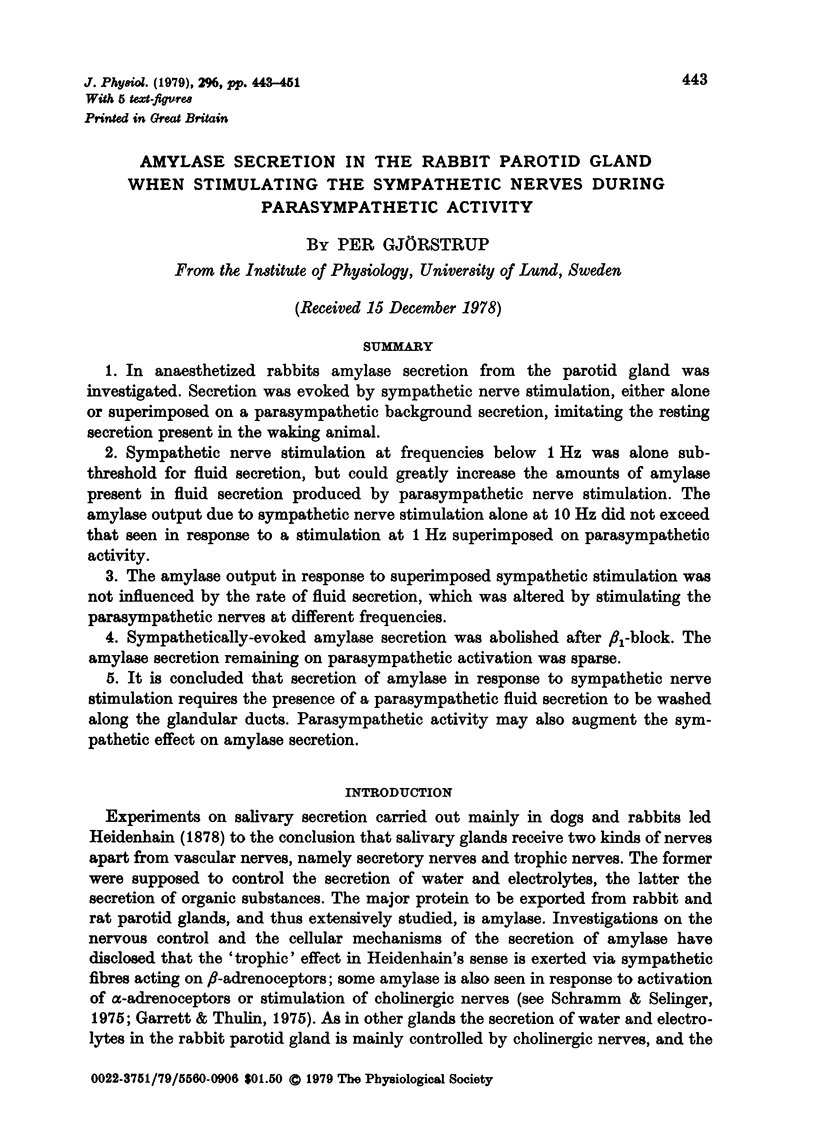
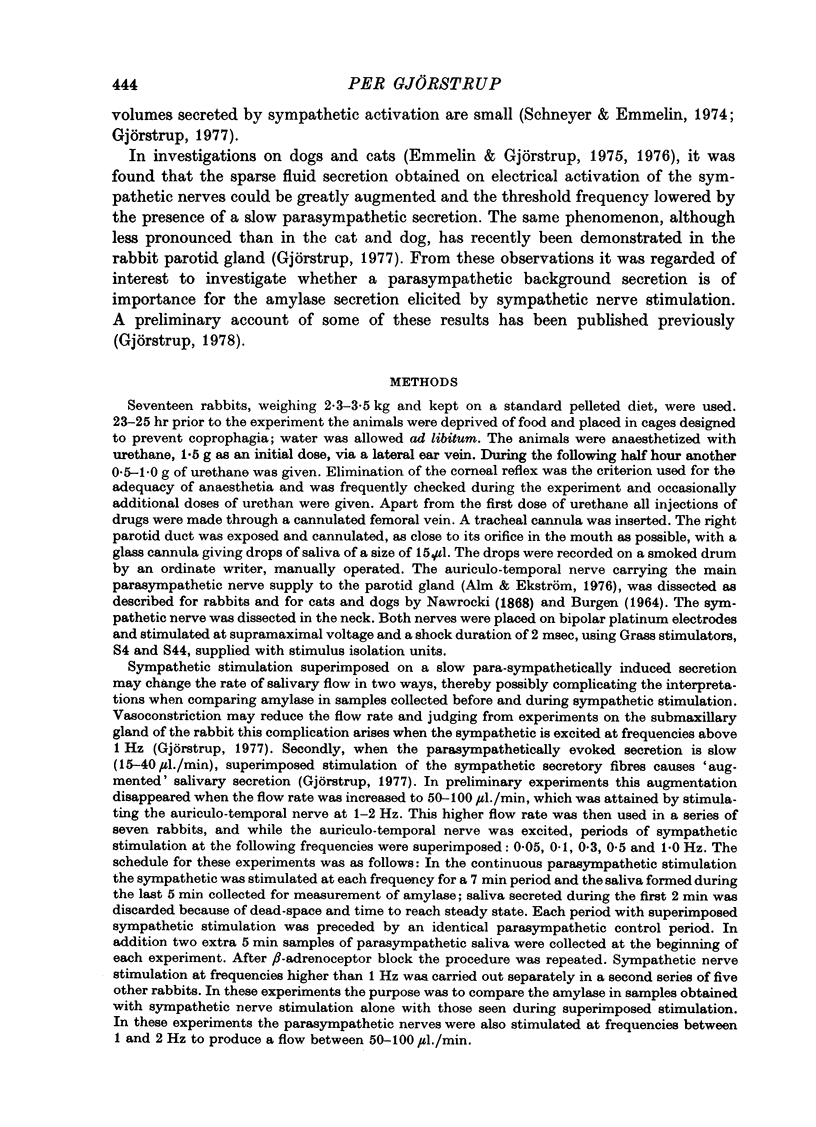


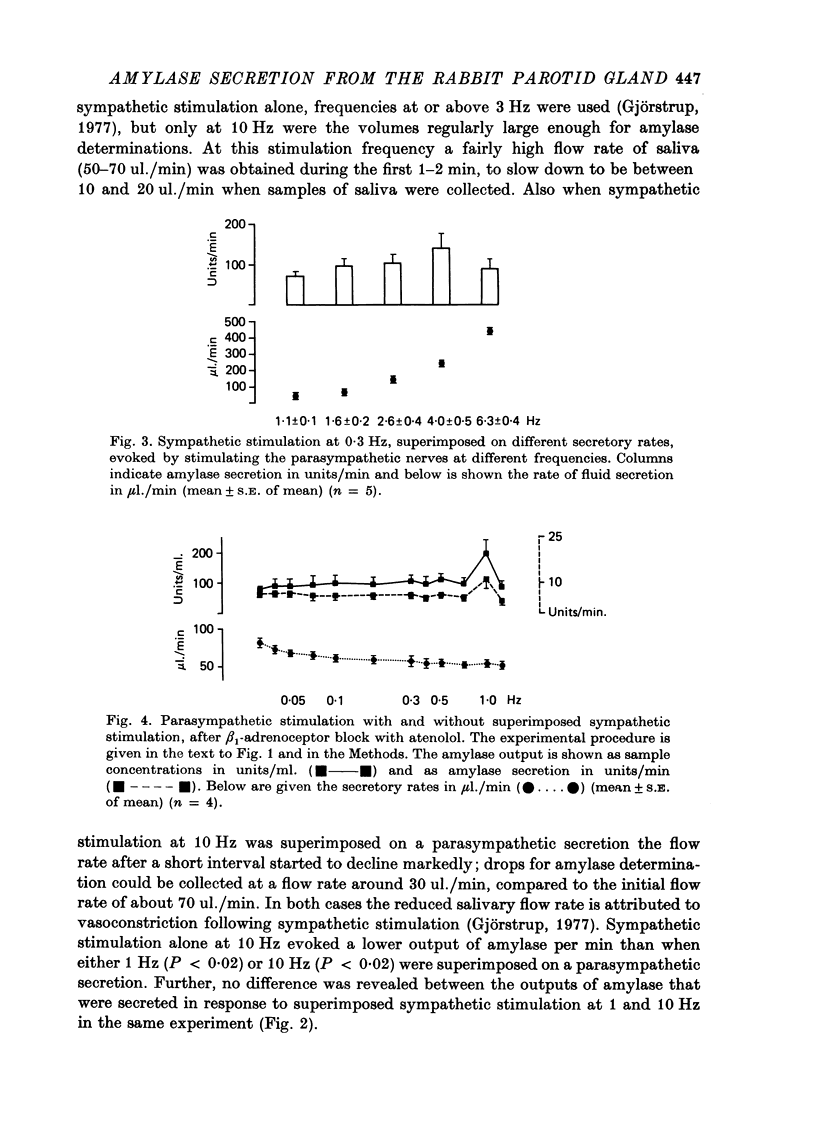
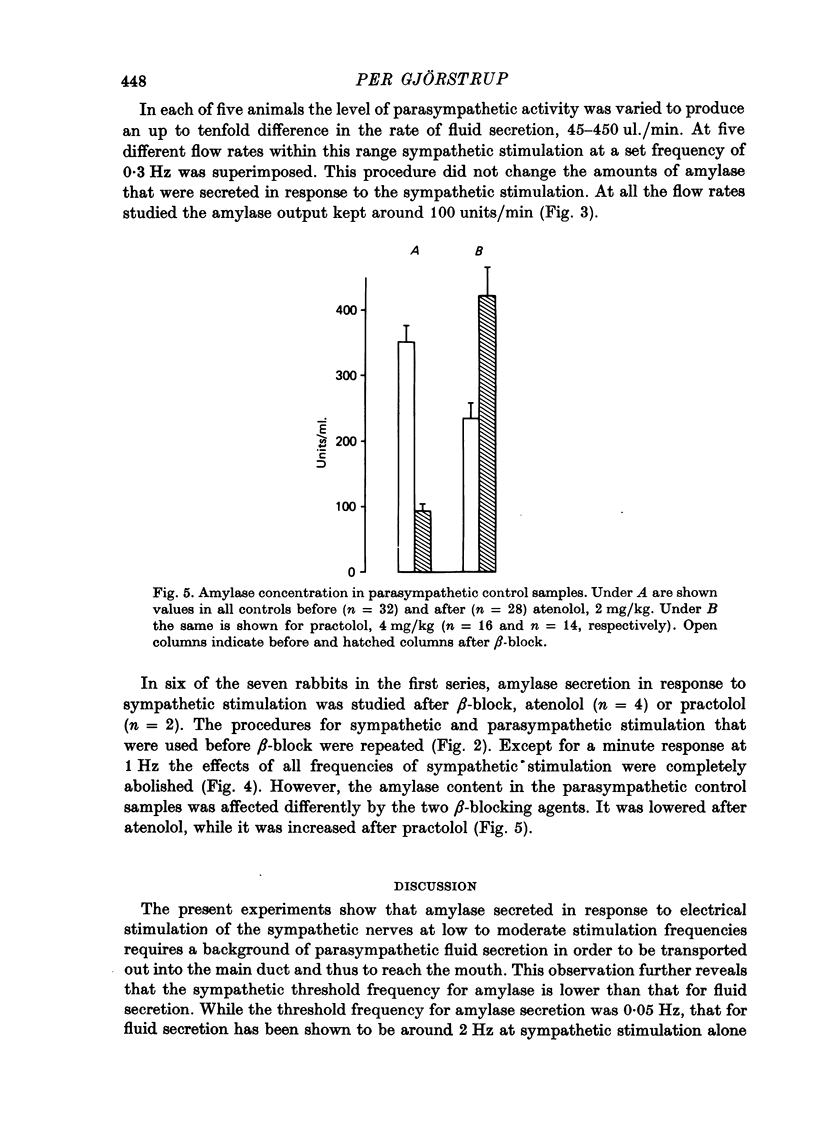
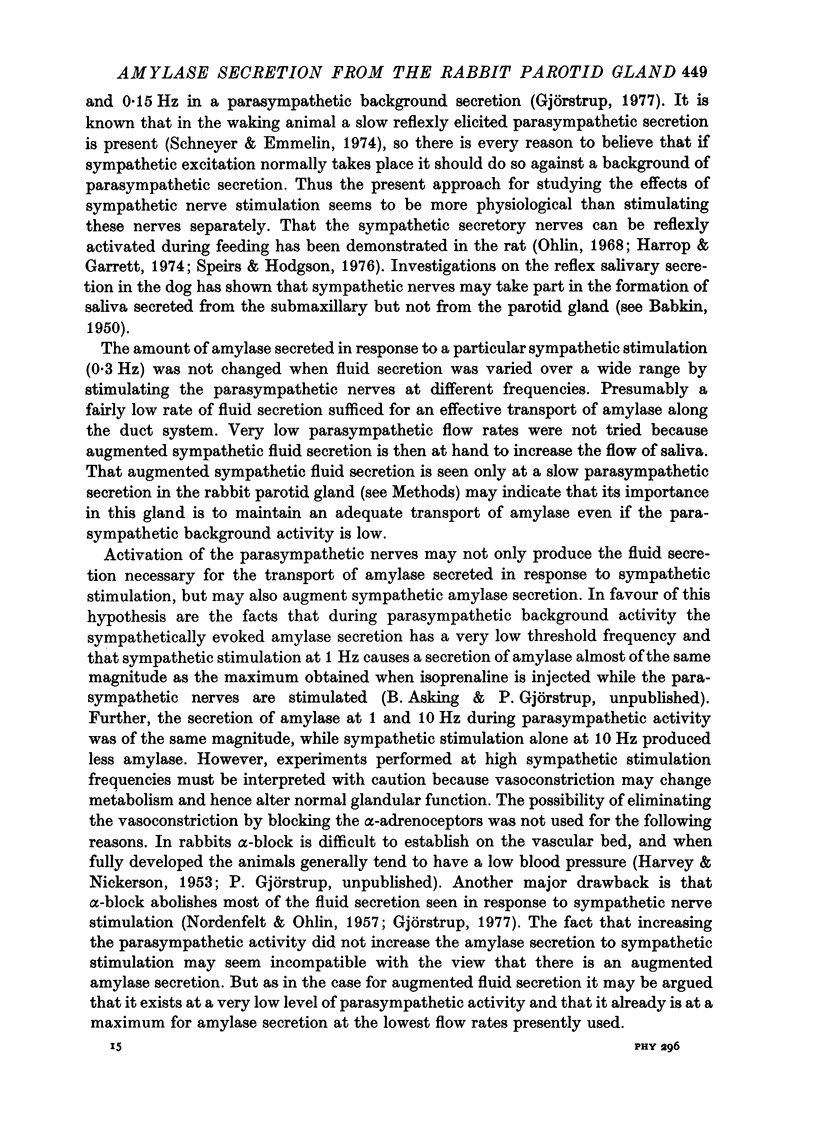

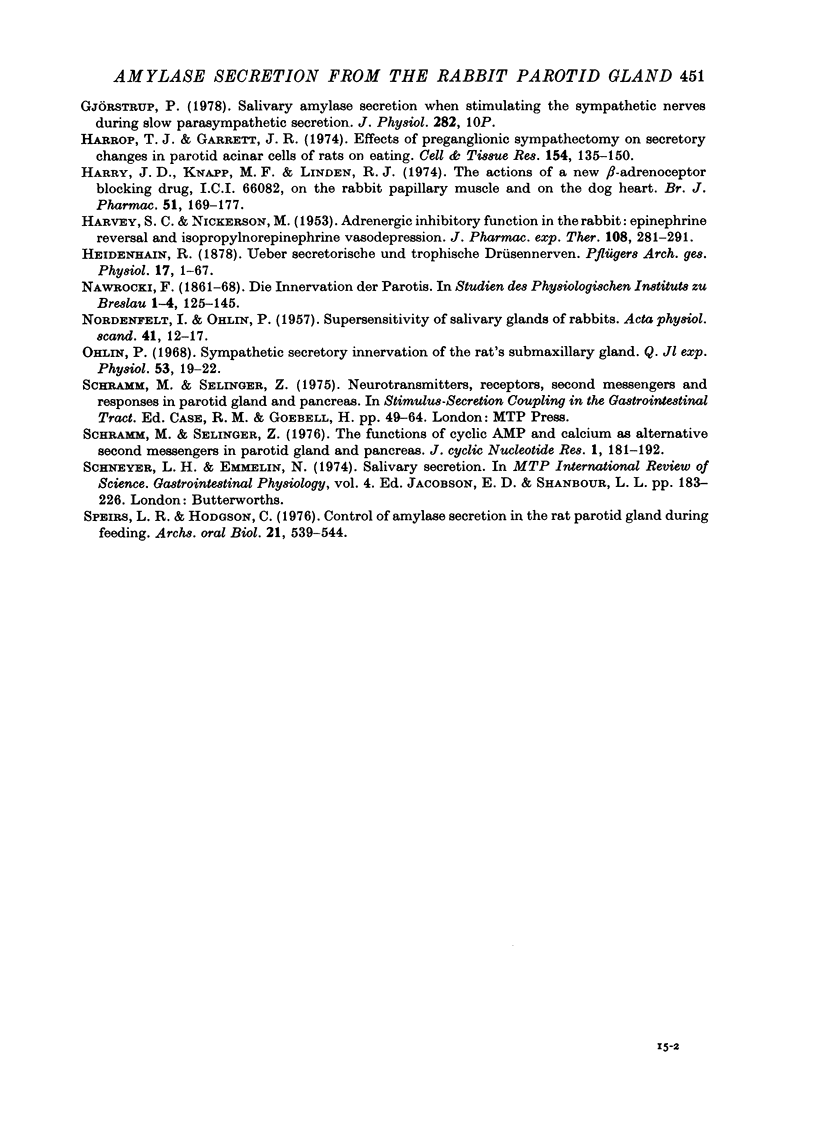
Selected References
These references are in PubMed. This may not be the complete list of references from this article.
- Alm P., Ekström J. Uncharted cholinergic nerves in the rabbit parotid gland. Q J Exp Physiol Cogn Med Sci. 1976 Apr;61(2):127–132. doi: 10.1113/expphysiol.1976.sp002343. [DOI] [PubMed] [Google Scholar]
- BURGEN A. S. TECHNIQUES FOR STIMULATING THE AURICULO-TEMPORAL NERVE AND RECORDING THE FLOW OF SALIVA. Int Ser Monogr Oral Biol. 1964;3:303–307. doi: 10.1016/b978-1-4832-2871-6.50026-6. [DOI] [PubMed] [Google Scholar]
- Barrett A. M., Carter J., Fitzgerald J. D., Hull R., Le Count D. A new type of cardioselective adrenoceptive blocking drug. Br J Pharmacol. 1973 Jun;48(2):340P–340P. [PMC free article] [PubMed] [Google Scholar]
- DAHLQVIST A. A method for the determination of amylase in intestinal content. Scand J Clin Lab Invest. 1962;14:145–151. doi: 10.3109/00365516209079686. [DOI] [PubMed] [Google Scholar]
- Ekström J. 4(2-hydroxy-3-isopropylaminopropoxy) acetanilide as a beta-receptor blocking agent. Experientia. 1969 Apr 15;25(4):372–372. doi: 10.1007/BF01899925. [DOI] [PubMed] [Google Scholar]
- Emmelin N., Gjörstrup P. Interaction between sympathetic and parasympathetic salivary nerves in anaesthetized dogs. Arch Oral Biol. 1976;21(1):27–32. doi: 10.1016/0003-9969(76)90156-4. [DOI] [PubMed] [Google Scholar]
- Emmelin N., Gjörstrup P. Secretory responses to sympathetic stimulation of the cat's salivary glands in a state of resting secretion. Q J Exp Physiol Cogn Med Sci. 1975 Oct;60(4):325–332. doi: 10.1113/expphysiol.1975.sp002326. [DOI] [PubMed] [Google Scholar]
- Garrett J. R., Thulin A. Changes in parotid acinar cells accompanying salivary secretion in rats on sympathetic or parasympathetic nerve stimulation. Cell Tissue Res. 1975 Jun 9;159(2):179–193. doi: 10.1007/BF00219154. [DOI] [PubMed] [Google Scholar]
- Gjörstrup P. Effects of sympathetic nerve stimulation in the presence of a slow parasympathetic secretion in the parotid and submaxillary glands of the rabbit. Acta Physiol Scand. 1977 Oct;101(2):211–218. doi: 10.1111/j.1748-1716.1977.tb06000.x. [DOI] [PubMed] [Google Scholar]
- Gjörstrup P. Salivary amylase secretion when stimulating the sympathetic nerves during slow parasympathetic secretion [proceedings]. J Physiol. 1978 Sep;282:10P–10P. [PubMed] [Google Scholar]
- HARVEY S. C., NICKERSON M. Adrenergic inhibitory function in the rabbit; epinephrine reversal and isopropylnorepinephrine vasodepression. J Pharmacol Exp Ther. 1953 Jul;108(3):281–291. [PubMed] [Google Scholar]
- Harrop T. J., Garrett J. R. Effects of preganglionic sympathectomy on secretory changes in parotid acinar cells of rats in eating. Cell Tissue Res. 1974;154(2):135–150. doi: 10.1007/BF00223160. [DOI] [PubMed] [Google Scholar]
- Harry J. D., Knapp M. F., Linden R. J. The actions of a new beta-adrenoceptor blocking drug, ICI 66082, on the rabbit papillary muscle and on the dog heart. Br J Pharmacol. 1974 Jun;51(2):169–177. doi: 10.1111/j.1476-5381.1974.tb09644.x. [DOI] [PMC free article] [PubMed] [Google Scholar]
- NORDENFELT I., OHLIN P. Supersensitivity of salivary glands of rabbits. Acta Physiol Scand. 1957 Nov 26;41(1):12–17. doi: 10.1111/j.1748-1716.1957.tb01506.x. [DOI] [PubMed] [Google Scholar]
- Ohlin P. Sympathetic secretory innervation of the rats submaxillary gland. Q J Exp Physiol Cogn Med Sci. 1968 Jan;53(1):19–22. doi: 10.1113/expphysiol.1968.sp001941. [DOI] [PubMed] [Google Scholar]
- Schramm M., Selinger Z. The functions of cyclic AMP and calcium as alternative second messengers in parotid gland and pancreas. J Cyclic Nucleotide Res. 1975;1(4):181–192. [PubMed] [Google Scholar]
- Speirs R. L., Hodgson C. Control of amylase secretion in the rat parotid gland during feeding. Arch Oral Biol. 1976;21(9):539–544. doi: 10.1016/0003-9969(76)90019-4. [DOI] [PubMed] [Google Scholar]


